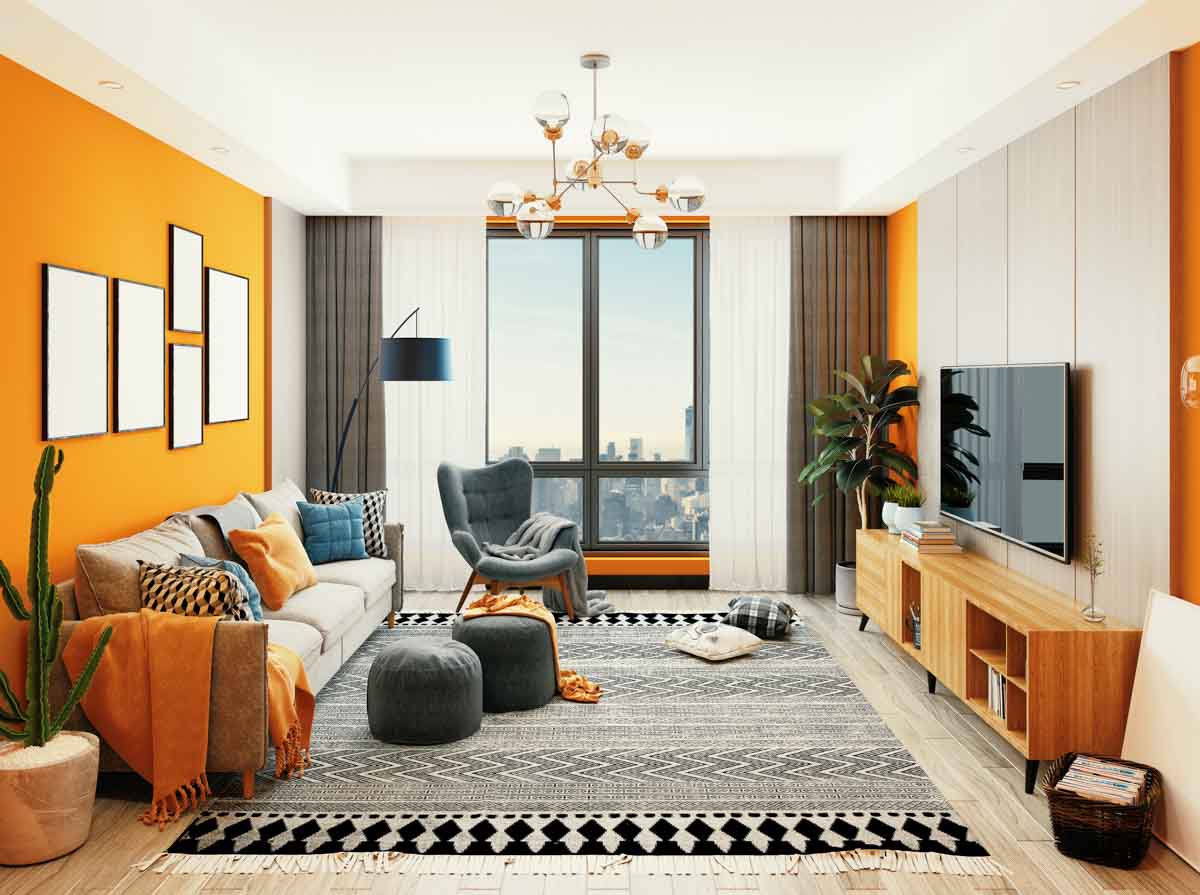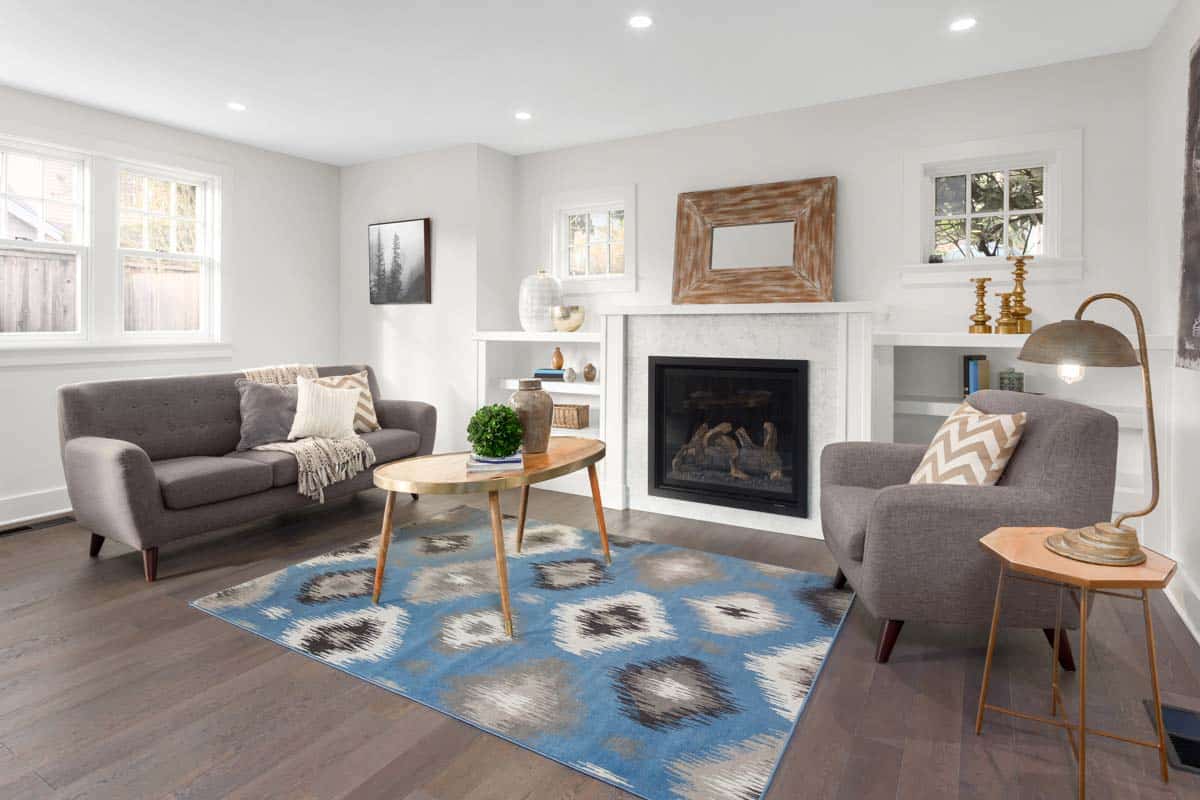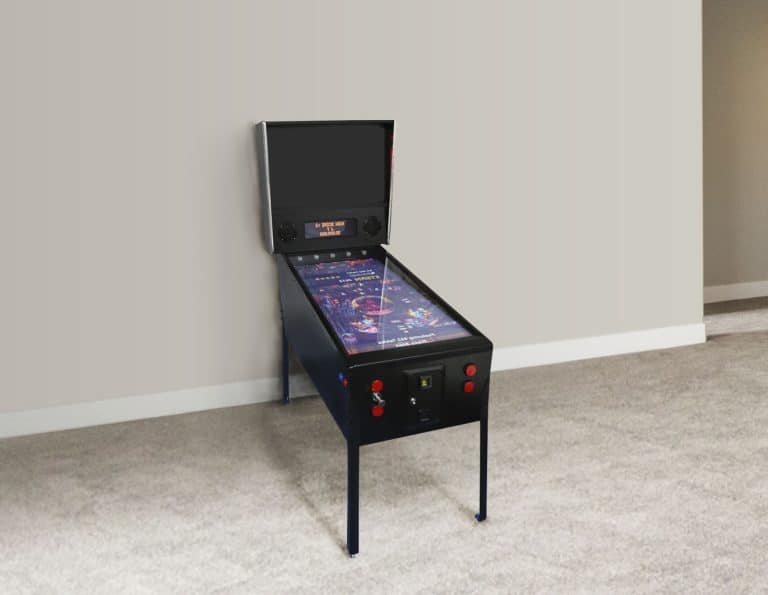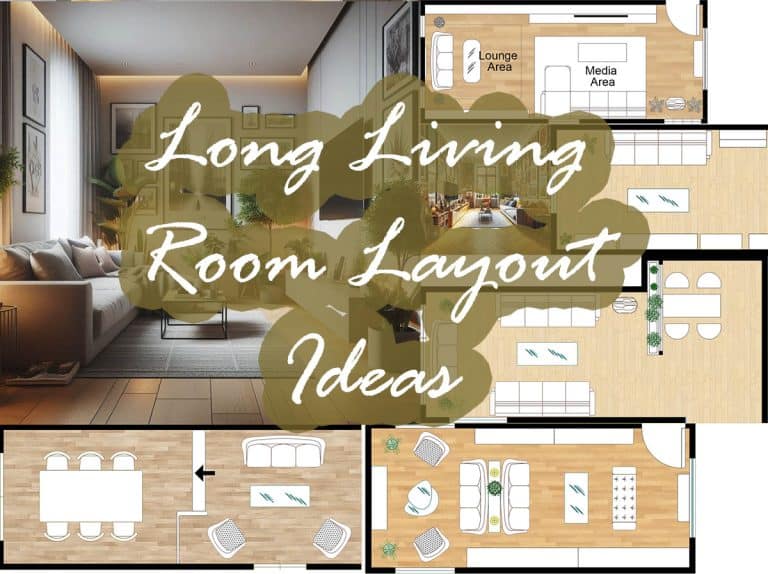What Size Rug for the Living Room (Interior Design Guide)
Transforming a living room from bland to beautiful often depends on a few crucial details. One of these is choosing the right rug. But, with all the options, such as proportion, balance, and functionality, determining the size rug best for the living room can be a mystery without expert advice and insight.
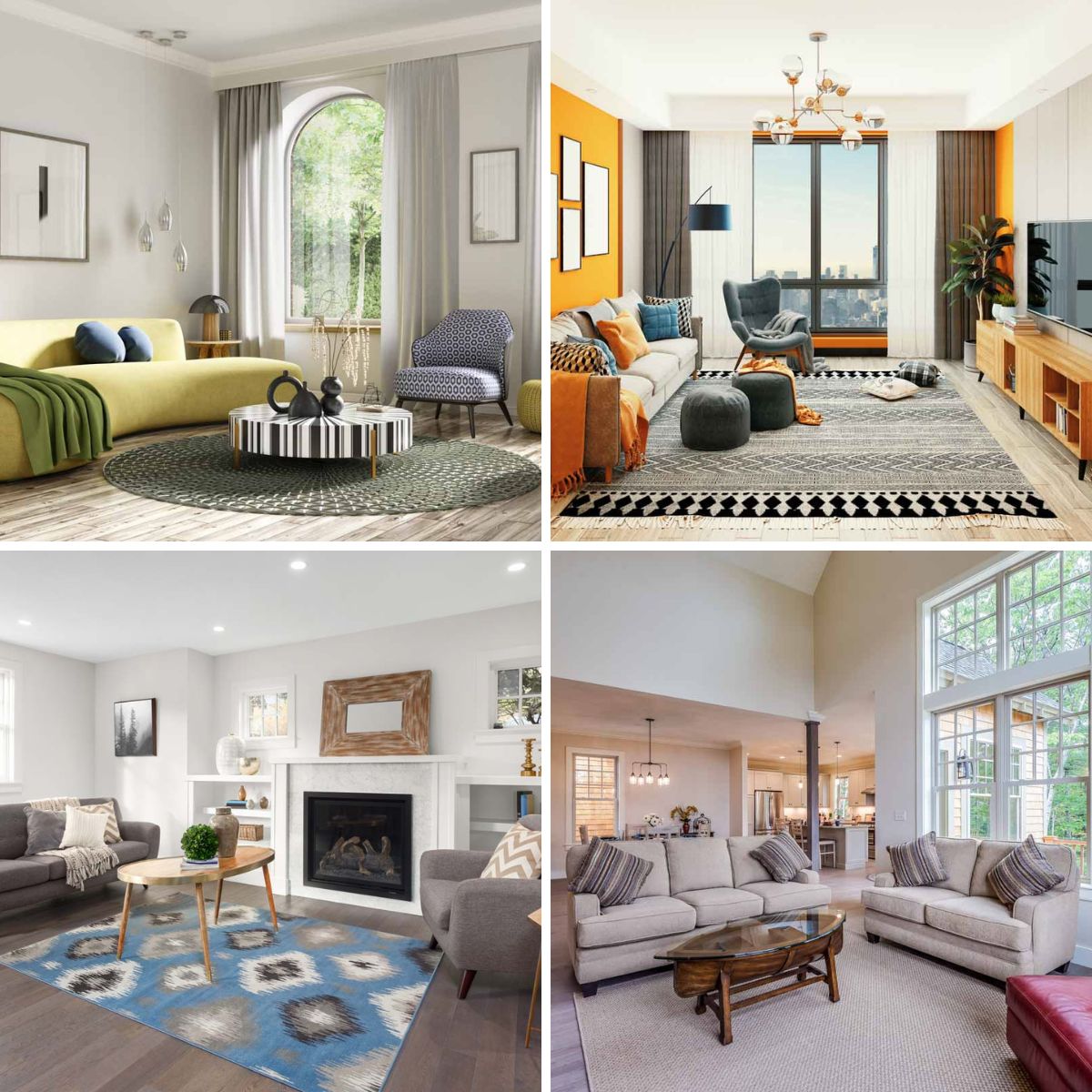
The issue for most homeowners and families is determining what size they should get. This guide addresses such concerns and helps families, individuals, and households choose the right rug for their living rooms.
Living Room Rug Size Guide
Although living room rugs have standard sizes, homeowners often cannot determine which product to buy—leading interior designers forward several “rules” for families to observe. These guidelines can help households identify the most appropriate floor covering for the living room.
The 12- to 18-inch Rule
One rule of thought is that rugs for living rooms require families to leave 12 to 18 inches of space between the area rug’s outer edges and the wall surface. It is an easy-to-remember rule, allowing homeowners to create a “border” between these elements, similar to how a picture frame contrasts the image and the wall.
Hence, homeowners must determine their living room dimensions and subtract 12 to 18 inches from the measurements to get the “ideal” floor covering size. For example, a living room measuring 16 by 20 feet will benefit from a 14- by 18-foot area rug (or something slightly smaller).
Area rugs are especially useful in the new open plan houses, or in older homes with big rooms devoted to more than use. – Better Homes and Gardens Decorating Ideas
This furnishing has a 12-inch allowance on all sides, creating the wall-rug border. Unfortunately, a 14- by 18-foot carpet might not be readily available. It is worth noting that the largest standard size for these rugs is 12 by 15 feet. Hence, the “12-to18-inch” rule might be inapplicable in exceptionally spacious rooms.
The 70% Rule
This guideline addresses the shortcomings of the “12-to-18-inch” rule. It allows homeowners to use area rugs covering at least 70% of the living room.
The 16×20-foot living room example has a square footage of 320 feet. Multiplying 320 square feet by 70% results in 224 square feet. Sadly, even the largest area rugs (12×15 feet) cannot meet this requirement. In such cases, homeowners might want to consider placing an area rug under furnishings as accent pieces.
Kevin O’Gara, an interior designer, advises that the area rug should be proportional to the room’s size. A good rule of thumb is that rugs should be at least one-third the size of the room. This ensures that it complements the furniture layout without making the room look unbalanced or cluttered. For instance, in rooms with a couch and chairs around a coffee table, the rug should be large enough to fit under at least the front legs of all the furniture to create a cohesive look and define the seating area.
The Small-Large Rule
Interior designers recommend placing rugs that are large enough to accommodate a small accent piece’s bottom (i.e., coffee table and sculpture stand). On the other hand, large furnishings must have at least two feet or legs on the carpet.
Examples of these include chairs, sofas, and loungers. Homeowners must also observe placement consistency, adhering to the “small-large” rule.
The Room “Feel” Rule
Interior decorators consider area rugs mood-creating pieces. Hence, homeowners and families must decide what vibe or feel they want to project in the living room.
For example, large-size area rugs that nearly hug the wall are ideal for creating an inviting ambiance. Family members and visitors would love to lie and sprawl on the carpet without a care in the world.
Meanwhile, smaller rugs are perfect for defining spaces, and transforming living rooms into sections with a purpose and a formal “feel.” Hence, families who want a more “organized” and “polished” look in the living room should pick a small area rug under accent pieces, decorative items, and functional furnishings.
The “Size Down” Rule
Akin to the 12-to-18-inch-rule, the size-down guideline is more specific to homes with cramped living rooms. Families must avoid placing a large area rug in such spaces because it will only make the floor plan look and feel smaller.
These “rules” can guide homeowners, individuals, and families to buy the correct area rug size for the living room. The question remains. What sizes are available? Families can choose from the following sizes.
Popular Sizes For Rugs
• 3 feet by 5 feet: Ideal for defining space and borders of living room furnishings
• 4 feet by 6 feet: An accent piece on the floor under coffee tables, decorative stands, or center tables
• 5 feet by 7 feet: A 35-square-foot carpet for accenting medium to large furnishings
• 5 feet by 8 feet: Ideal for accommodating a center table with surrounding chairs and sofas
• 6 feet by 9 feet: Offers a 54-square-foot coverage for furniture sets
• 8 feet by 10 feet: A common size for many homes with 115-square-foot living rooms
• 9 feet by 12 feet: Recommended for rooms with a floor area of at least 155 square feet
• 12 feet by 15 feet: Ideal for spacious rooms with an area of at least 260 square feet
Round Rug Size
Some families prefer round rugs in the living room to rectangular versions because they are cozy and create a feeling of intimacy. Circular area rugs “draw” the corners and edges of a living space toward the center, allowing families to produce a focal point.
Unlike conventional rectangular area rugs with two measurements (length and width), families only need to consider a round rug’s cross-section or diameter. The following are the common circular sizes homeowners must familiarize themselves with.
• 4 feet: An accent piece for covering the floor underneath a center table or a small 36-square-foot floor plan
• 6 feet: A round decor piece perfect for a small 8-by-8-foot living room
• 8 feet: Recommended for a 10-foot by 10-foot living room
• 10 feet: Ideal for 12-foot by 12-foot rooms, creating a 1-foot border on all sides
How to Choose Rug Dimensions for the Living Room
Choosing the right rug size for the living room can be challenging and daunting, especially for first-time homeowners or families with insufficient “interior decorating” know-how. Here are some tips to consider.
• Determine the living room’s square footage: The first order of battle is sizing up the living room. This step is necessary to zero-in on the most appropriate carpet size, considering the “rules” explained above.
For example, most homeowners adhere to the 12-to-18-inch border rule, giving them the luxury of looking for an area rug about two feet smaller than the living room’s dimensions.
Suppose a living room spans its longest side by 10 feet and crosses right to left at 8 feet. Families with these dimensions can detract two feet from the room’s width and length. The result will be 6 feet by 8 feet. And that’s the most appropriate area rug size for such a room.
Families can also observe the 18-inch border rule if they want more substantial floor space between the rug and wall. In such cases, the 6×8 size would be too large. A nicer option would be a 5 x 7 size. Although smaller, the rug can still make the design layout cozy and inviting.
Another option would be to determine the living room’s 70% dimensions. The 10×8-foot example above has a 70% floor area of 56 square feet. Such a dimension makes a 7 x 8-foot area rug ideal. Of course, families can choose a slightly bigger area rug.
• Consider the furnishings in the living room: Although the 12-to-18-inch-rule or 70%-rule make excellent guides for choosing the right area rug size, some situations make these guidelines irrelevant or inappropriate.
For example, given that a 12 x 15-foot area rug is the largest, it can only cover 180 square feet. The maximum living floor space it can cover (following the 70% rule) is only 257 square feet. Everyone knows some households have supersized rooms exceeding 300 square feet. What then?
Families must consider area rugs like islands in the living room. They are like canvas with furnishings and decorative elements forming the image. In such instances, clustering the furnishings under a large carpet is practical and aesthetically sound.
The idea is to create “zones” within the living room without using dividers, allowing families to draw attention to specific groups. Such arrangements require homeowners to observe a 6-inch rule. This guideline assumes the area rug should be half a foot larger than the furnishing’s outer edges. For instance, an 18-inch-wide coffee table will look extravagant over a 30-inch-wide area rug.
• All-Feet or Front-Legs?: Interior decorators look at area rugs as islands or canvases, and families might want to start looking at these items as such. So, homeowners must decide whether to put all furnishings on the area rug (all-feet layout) or keep the rear floating or grounded on the “rug-uncovered” floor.
As the name implies, an all-feet arrangement places furnishings (i.e., tables, desks, sofas, loveseats, and chairs) ON the area rug. Moreover, families must position the furnishings to ensure their rear edges are at least 8 inches from the area rug’s edge. Families adhering to this layout can pick a 10 x 14, 8 x 10, or 9 x 12 carpet.
The all-feet method is ideal for cramped living rooms. But if one has sufficient space, the front-legs-only approach is preferable. This layout requires the rear sections of furnishings grounded on the floor and only the front legs are on the carpet. Ideally, the carpet must cover the furnishing’s front third. Excellent choices for this arrangement include 5 x 7 and 8 x 10.
What Size Rug for the Sofa?
Sofas vary in size depending on the brand, seating capacity, and model type. For instance, a living room sofa that can accommodate three adults can have a side-to-side span of 84 inches.
Although most sofa styles vary in dimensions, a good rule to observe is the 6-inch guideline. It states that families must pick an area rug about half a foot wider than the sofa on the left and right sides. Hence, an 84-inch-wide living room sofa will look more fantastic with a 9-foot-wide (108 inches) carpet underneath.
Should the Rug be Bigger than the Couch?
Interior decorators say that couches are primarily for improving comfort, while sofas have a more “formal” or classic function. Despite these functional differences, a couch still requires an identical area rug sizing as a sofa.
Hence, homeowners must observe a 6- to 8-inch allowance on the couch’s left and right sides to determine the ideal area rug size. This requirement makes the living room rug 12 to 16 inches bigger than a couch.
Deborah von Donop, an interior designer, suggests considering the carpet materials based on your lifestyle. For instance, wool carpets are popular for their softness, durability, and natural stain resistance, while plant-based fibers like bamboo are valued for their durability and affordability. She also recommends choosing a carpet after selecting base finishes like wood floor tones and upholstery. In terms of their size, von Donop advises using painter’s tape to visualize the dimensions in your space, ensuring the rug you choose fits well with your room’s layout and design.
What Size Area Rug for Couch and Loveseat?
Loveseats are 2-seater sofas, perfect for snuggling and promoting worthwhile intimate moments with partners. These furnishings come in three widths (left-to-right): 48 to 62 inches, 58 inches, and 72 inches. Meanwhile, the average 3-seater sofa measures 84 inches, although some families might have a 4-seater or 5-seater variant.
Hence, the area rug size for a living room with a loveseat and couch depends on these furnishings’ measurements. Most interior designers recommend an area rug at least 8 feet wide and 10 feet long. If homeowners are unsure about these suggestions, they could opt for a larger 9-foot by 12-foot area rug to cover the loveseat and couch.
What Size Area Rug for Open Concept Room?
Many modern homeowners opt for an open concept floor plan, allowing them to improve foot traffic and promote entertainment. It also gives the home a more spacious look. Unfortunately, some families find choosing an area rug for an open living room challenging.
The “ideal” area rug size for such open spaces depends on the living room section’s dimensions. The 70% and 12-to-18-inch border rule is applicable. For example, if there’s sufficient space in the open concept layout, a 12-foot by 15-foot covering will be nice. Alternatively, a 9×12 covering should be enough to accommodate a large corner sofa or a pair of floating couches.
Most open concept living rooms use 8 x 10 rugs, although a 6 x 9 option should still be an excellent choice for small homes. Families must resist the temptation of placing a 5×8 size in an open concept floor plan.
Does a Larger or Smaller Rug Make a Room Look Bigger?
Interior decorators consider a larger rug more advantageous in making a living room look bigger than a smaller version. However, they caution homeowners to observe at least 12 inches from the rug’s edges to the walls. This rule makes the floor covering like a canvas and the border as the frame.
Some homeowners think placing several smaller rugs in the living room will make it look more spacious. Unfortunately, this is not the case. Too many rugs laid individually may detract from the room’s aesthetics, creating a disorganized floor plan.
Interior designer, Shea McGee, is known for her approach to layering smaller, decorative rugs on top of larger, natural weave ones. McGee suggests using rugs in the kitchen as well, citing their ability to add warmth and texture to the room. For outdoor spaces, she recommends styling the area with an outdoor rug to complement the colors of your cushions and table setting, enhancing the overall dining experience.
Living rooms are a home’s most important sections, allowing families to welcome and entertain visitors in a warm and comfortable environment. Unsurprisingly, families spend a fortune “beautifying” the living room by adding decorative elements (i.e., paintings, sculptures, antiques, artwork, and accent lights).
Unfortunately, some households overlook an area rug’s ability to transform any room into a warm and welcoming space. These smaller-than-carpet furnishings can add warmth, color, and texture to the living room, instantly converting it into a five-star hotel-like area for everyone to relax and enjoy a good vibe.
See more related content in our article about natural fiber rugs that are soft on this page.




